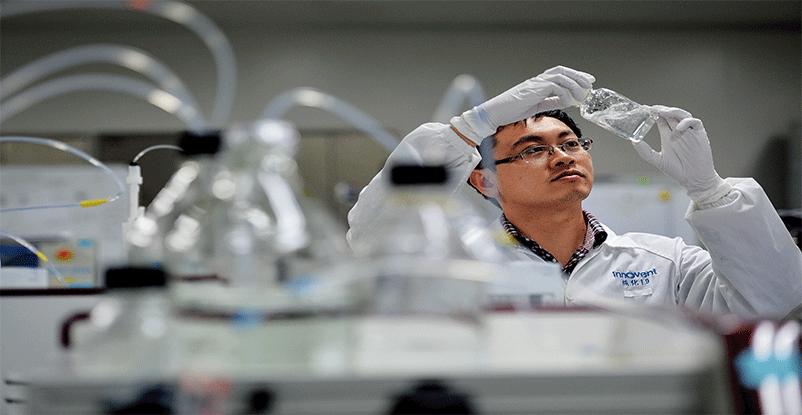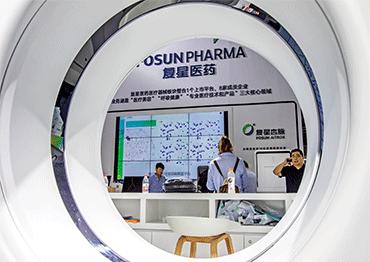Li Jizong, director of Shanghai Center for Biomedicine Development, noted that the expansion of pharmaceutical products overseas does not mean companies can rest on their laurels. Instead, they need to work harder to stay competitive in the global market.
Competition is also escalating among companies rushing to develop targeted therapies. “Many companies developing ADCs, for example, start with HER2 or TROP2-targeted therapies (for breast, bladder, pancreatic, ovarian and stomach cancers) which are already very mature, making it challenging for them to gain a competitive edge,” MediLink CEO Xue Tongtong said.
Innovative drug R&D is high risk and involves substantial investment.
Chen Yuan, who works for a listed Chinese pharmaceutical company, told NewsChina there is a common saying in the industry that developing a new drug “takes a decade of research and US$1 billion in investment but has a clinical trial success rate of 10 percent.”
As an example, he cited the first several companies approved to develop PD-1 inhibitors, which enable the immune system to better target and kill cancer cells, who invested at least 2 billion yuan (US$278m) each in follow-on innovation.
Chen expressed concerns that the fierce competition, reduced medical insurance prices for PD-1 drugs and unfavorable payment policies for innovative drugs in China are hindering development.
The price of domestic innovative drugs in China is notably lower compared to overseas markets, which strains profit margins.
For example, Junshi Biosciences’ Toripalimab sells for US$8,892 per bottle in the US. In China, it costs US$266.
While companies see global expansion as a necessary step for survival, few are able to do so, Ding Sheng said.
Meanwhile, the decline in investment has become a pressing issue for the industry, said Ding Lieming, chairman and CEO of oncology drug maker Betta Pharmaceutical.
Data from industry data platform Pharmcube shows a significant drop in financing for innovative drugs in the Chinese market from 87.7 billion yuan (US$12.2b) to 30.9 billion yuan (US$4.3b) between 2021 and 2023.
Bi Jingquan, a member of the 14th CPPCC National Committee and executive vice president of the China Center for International Economic Exchanges, noted last December that many of the innovative drugs and overseas licensing projects launched in recent years were the results of venture capital investments made five years ago. At the fifth “Healthy China” forum held in Beijing in January, Bi said that a drop in venture capital investment would result in fewer breakthroughs in innovative drugs, posing significant funding challenges for numerous companies.
Ding Sheng noted that given the cost and time required to develop a new drug, higher returns to pharmaceutical companies are necessary to incentivize drug innovation.
This balancing act between high demand for innovation, substantial R&D investment and constrained profit margins was a focal point during the two sessions, China’s annual parliamentary meetings held in March, where attending industry leaders offered suggestions to tackle the challenge.
CPPCC member Ding Lieming suggested that companies should be granted autonomy to set prices of innovative drugs for a five-year period. He emphasized highlighting the clinical value of innovative drugs in medical insurance negotiations to ensure reasonable pricing, and increasing reimbursements in medical insurance to cover these new drugs.
Wu Depei, a CPPCC member and professor from the First Affiliated Hospital of Soochow University in Suzhou, suggested establishing protections for high-value innovative drugs with independent intellectual property rights, allowing them to be sold at regulated prices during a set period.
The government has taken steps to reform pricing of innovative drugs. In late January, an implementation plan for pilot reforms in Shanghai’s Pudong New Area allows new biopharmaceutical drugs to be priced based on international market comparisons.
Similarly, the National Healthcare Security Administration on February 5 released a draft on establishing a pricing mechanism for newly launched chemical drugs to encourage innovation and solicited feedback from industry associations. The draft proposes granting products with higher innovative value greater freedom in setting their initial prices.
Despite these efforts, several interviewed analysts expressed their concerns about China’s ability to innovate.
They emphasized the need for robust basic research and innovation that aligns with clinical needs. While China is a leader in biopharmaceutical research, its basic research capabilities still need to be strengthened to drive original innovation, Li Ning noted.
Ding Sheng pointed out that the majority of Chinese companies currently focus on follow-on innovation. “Domestic research is still at a stage of winning by quantity. Not every company has differentiated products,” he explained.
It is critical to advance the understanding of the causes of diseases, which depends on the progress of basic research, Ding Sheng said.
With only a few new internationally recognized drugs under its belt, China needs to enhance its capabilities and increase production of innovative drugs to match its scale, Ding Sheng said.

 Old Version
Old Version

